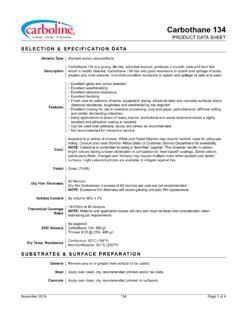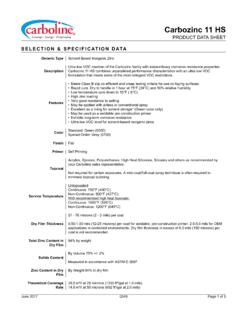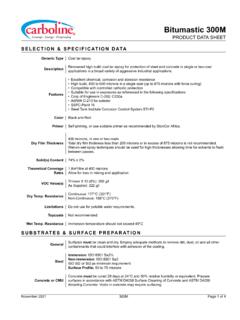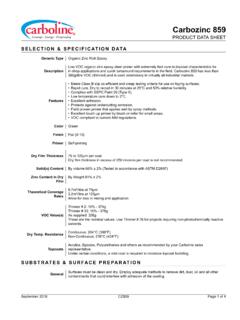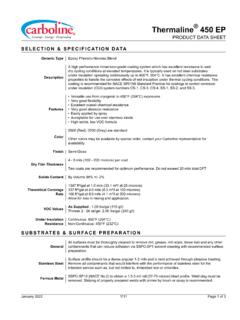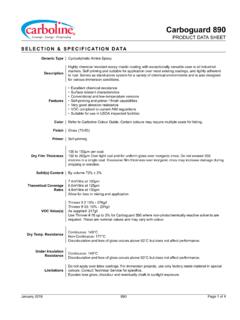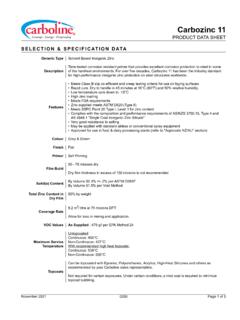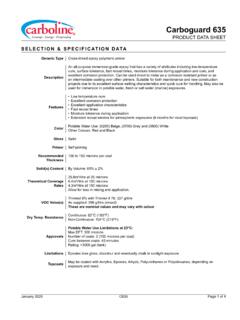Transcription of Carbothane 134 HG - Carboline
1 Carbothane 134 HGPRODUCT DATA SHEET November 20210859 Page 1 of 4 SELECTION & SPECIFICATION DATA Generic TypeAliphatic Acrylic Polyurethane DescriptionThin film, high gloss finish with exceptional weathering performance characteristics. Usedextensively in virtually all industrial markets, 134 HG provides a smooth, durable finish that hassuperior resistance to corrosion, abrasion and chemical exposure. Features High solids, low VOC content Excellent weatherability Exceeds SSPC Paint 36 specification for a Level 3 urethane Conforms to the requirements of AS/NZS :2009, Type 1 "Paints for Steel Structures - FullGloss Polyurethane (two pack)" Approved for use in food & dairy processing plants (refer to "Approvals NZ/AU" section) Excellent flow characteristics allow for application by spray or roller Superior impact and abrasion resistance Indefinite recoatability Colour NZ Standard: White, Black, & Golden Yellow AU Standard: White, & Golden Yellow AU/NZ Tinted.
2 Available in most British Standard, AS 2700, Resene colours and custom tints. FinishGloss PrimerRefer to Substrates & Surface Preparation. Film Build50 - 75 microns dry per coat Solid(s) ContentBy Volume 70% +/- 2% Theoretical CoverageRates14 m /litre at 50 microns m /litre at 75 microns dryAllow for loss in mixing and application. VOC ValuesAs Supplied : 264 g/lThinner 25 : 20% v/v 366 g/l These are nominal values and may vary slightly with color. Dry Temp. ResistanceContinuous: 149 C (300 F) Some discoloration and loss of gloss may be experienced at elevated temperatures. LimitationsApplication method (ie spray v brush) may affect final colour tone and texture; care must be takento keep conditions as constant as possible to reduce variations in final appearance.
3 It is alsoadvisable to work from a single batch of material since variations can occur from batch to batch. Formore information consult Carboline Technical Service Department. TopcoatsCarbothane 130 Clear Coat when required for graffiti resistance (NZTA/AMA approved) or extremeweatherabilityCarbothane 134 HGPRODUCT DATA SHEET November 20210859 Page 2 of 4 SUBSTRATES & SURFACE PREPARATION GeneralSurfaces must be clean and dry. Employ adequate methods to remove dirt, dust, oil and all othercontaminants that could interfere with adhesion of the coating. For all surfaces prime and / orundercoat with specific Carboline coating as recommended in the relevant Coating to the specific primer or undercoat Product Data Sheet for detailed requirements.
4 Galvanised SteelPrime with specific Carboline primer as recommended by your Carboline Sales to the specific primer s Product Data Sheet for substrate preparation requirements. Previously PaintedSurfacesLightly sand to roughen and degloss the surface. Existing paint must attain a minimum 3A rating inaccordance with ASTM D3359 XScribe adhesion test. Prime with specific Carboline primers asrecommended by your Carboline Sales Representative or Carboline & THINNING MixingPower mix Part A separately, then combine with Part B and power mix. DO NOT MIX PARTIALKITS. ThinningSpray: Up to 20% w/ Thinner #25 Brush: Up to 20% w/ Thinner #22 Roller: Up to 20% w/ Thinner #22 Use of thinners other than those supplied or recommended by Carboline may adversely affectproduct performance and void product warranty, whether expressed or implied.
5 Ratio4:1 Ratio (A to B) Pot Life4 Hours at 24 C and less at higher temps. Pot life ends when coating becomes too viscous to CONTAMINATION WILL SHORTEN POT LIFE AND CAUSE EQUIPMENT GUIDELINES Listed below are general equipment guidelines for the application of this product. Job site conditions may require modificationsto these guidelines to achieve the desired results. Spray Application(General)This is a high solids coating and may require adjustments in spray techniques. Wet film thicknessis easily and quickly achieved. Spray equipment is available from manufacturers such as Binks,DeVilbiss and Graco.
6 Conventional SprayPressure pot equipped with dual regulators, mm (3/8 ) minimum material hose, mm( ) fluid tip and appropriate air cap. Airless Spray*Pump Ratio: 30:1 : 11 lt/minute Hose: mm (3/8 ) Size: Output PSI: 2100-2400 Filter Size: 60 mesh *Teflon packings are recommended and available from the pump manufacturer. Brush & Roller(General)Multiple coats may be required to obtain desired appearance, recommended dry film thickness andadequate hiding. Avoid excessive re-brushing or rerolling. For best results, tie-in within 10 minutesat 24 C. Carbothane 134 HGPRODUCT DATA SHEET November 20210859 Page 3 of 4 APPLICATION EQUIPMENT GUIDELINES Listed below are general equipment guidelines for the application of this product.
7 Job site conditions may require modificationsto these guidelines to achieve the desired results. BrushRecommended for touch-up and small areas only. Use a medium, natural bristle brush. RollerUse a short-nap mohair roller cover with phenolic CONDITIONS ConditionMaterialSurfaceAmbientHumidityM inimum10 C (50 F)2 C (36 F)2 C (36 F)0%Maximum38 C (100 F)49 C (120 F)35 C (95 F)80% Industry standards are for substrate temperatures to be above 3 C the dew : This product is moisture sensitive in the liquid stage and until fully cured. Protect from high humidity, dew and moisturecontact until fully cured.
8 Application and/or curing in humidities above maximum, or exposure to moisture from rain or dew mayresult in a loss of gloss and/or micro-bubbling of the SCHEDULE Surface to HandleDry to Recoat & Topcoatw/ other finishesFinal Cure General2 C (35 F)36 Hours36 Hours14 Days10 C (50 F)16 Hours16 Hours10 Days24 C (75 F)8 Hours8 Hours7 Days32 C (90 F)4 Hours4 Hours5 Days These times are based on a 50 micron dry film thickness. Higher film thickness, insufficient ventilation or cooler temperatures willrequire longer cure times and could result in solvent entrapment and premature failure.
9 *Maximum self-recoat times are indefinite. Surface must be clean and dry. As part of good painting practice it is recommendedto test for adhesion by wiping the surface with Thinner #25. If the film shows a slight tack the surface is suitable for recoatingwithout extensive surface preparation such as Accelerator can be used to accelerate the film forming process in this product for conditions outside of theparameters of this data sheet. Polyurethane Accelerator is added at a rate of 5 ml per mixed litre or a maximum of 25 ml per mixedfive litres. At this addition rate, Polyurethane Accelerator will accelerate the cure rate of the urethane product between 25-40%depending on the substrate temperature range and reduce the pot life of the product by approximately 40-50% of that stated on theproduct data sheet.
10 With the use of Polyurethane Accelerator, this product will continue to cure at temperatures as low as -7 & SAFETY CleanupUse Thinner #2, #25 or Acetone. In case of spillage, dispose of in accordance with local applicableregulations. SafetyRead and follow all caution statements on this product data sheet and on the MSDS for this productand use personal protective equipment as directed. VentilationContains iso-cyanate. When sprayed may be harmful by inhalation - do not breathe vapouror spray. Wear suitable clothing, gloves, eye and face protection, including suitable breathingprotection such as an air supplied respirator or used in enclosed areas, thorough air circulation must be used during and after applicationuntil the coating is cured.
